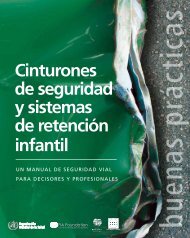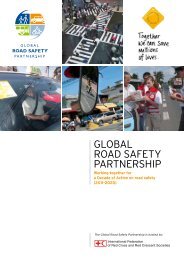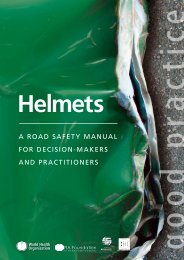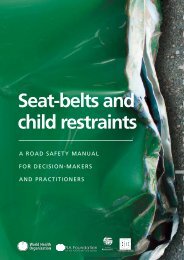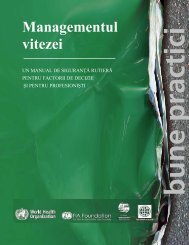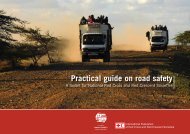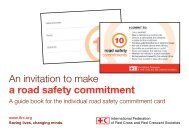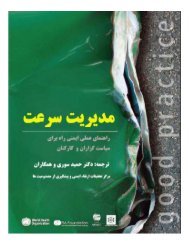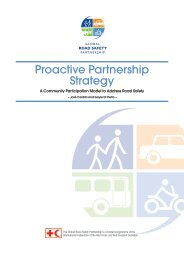How to design and implement a drinking and driving programme pdf ...
How to design and implement a drinking and driving programme pdf ...
How to design and implement a drinking and driving programme pdf ...
You also want an ePaper? Increase the reach of your titles
YUMPU automatically turns print PDFs into web optimized ePapers that Google loves.
Drinking <strong>and</strong> Driving: a road safety manual<br />
BOX 3.11: THINK! An integrated publicity campaign, United Kingdom<br />
The UK’s THINK! campaign television advert, “Crash”, was launched in 2004. It warned that it takes less than<br />
you think for your <strong>driving</strong> <strong>to</strong> be impaired by <strong>drinking</strong> alcohol, <strong>and</strong> supported the strategy of “just saying no”.<br />
The advert shows three men meeting after work for a quiet drink. One of the men gets in a second round, <strong>and</strong><br />
our “hero” tries <strong>to</strong> decline because he is <strong>driving</strong>. <strong>How</strong>ever, he quickly gives in, thinking, “after all it’s only two”.<br />
The advert dramatises that exact moment of decision-making <strong>and</strong> shows the consequences of that second<br />
drink. It also raises the idea that you become a drink-driver in the pub, not on the road.<br />
A radio advert, leaflet <strong>and</strong> posters were developed as part of an integrated campaign. The national radio advert<br />
focuses on the moment in a pub when we decide <strong>to</strong> stay for that extra drink – or not.<br />
The leaflet <strong>and</strong> posters support the TV <strong>and</strong> radio adverts by reinforcing the message that it is impossible <strong>to</strong><br />
calculate your alcohol limit, so you shouldn’t risk guessing.<br />
More information: www.thinkroadsafety.gov.uk/campaigns/drinkdrive/drinkdrive.htm<br />
Timeline of publicity campaign relative <strong>to</strong> law <strong>and</strong> enforcement activity<br />
The timing of a <strong>drinking</strong> <strong>and</strong> <strong>driving</strong> publicity campaign in respect <strong>to</strong> related activities<br />
such as changes in the law <strong>and</strong> police enforcement is an important fac<strong>to</strong>r in the<br />
overall success of changing road user behaviour. Coordination among the initiatives<br />
is critical.<br />
Typically people are more prepared <strong>to</strong> change their behaviour if it means that they<br />
are complying with the law rather than simply being urged <strong>to</strong> do something because<br />
“it makes sense”. An example of this is the experience of the United Kingdom in relation<br />
<strong>to</strong> seat-belt wearing. After many years of “persuasive” advertising that produced<br />
only limited behaviour change, the law was changed <strong>to</strong> make seat-belt use compulsory.<br />
As a result of this change in legislation, wearing rates in the UK went from being<br />
one of the lowest in Europe <strong>to</strong> the highest.<br />
Similarly it is important <strong>to</strong> publicise, either by campaigns or mass media coverage,<br />
any changes in (typically more or <strong>to</strong>ugher) enforcement activity. Visible <strong>and</strong> frequent<br />
enforcement is critical in persuading the general public <strong>to</strong> obey <strong>drinking</strong> <strong>and</strong> <strong>driving</strong><br />
laws, <strong>and</strong> not just <strong>to</strong> catch those breaking them. Enforcement works because it acts as<br />
a deterrent. Thus, informing the public about enforcement activities can deter people<br />
from <strong>drinking</strong> <strong>and</strong> <strong>driving</strong> by increasing their perception of being caught.<br />
Long-term <strong>and</strong> sustainable changes in public perception <strong>and</strong> driver behaviour,<br />
especially in relation <strong>to</strong> behaviour such as <strong>drinking</strong> <strong>and</strong> <strong>driving</strong>, are not generally<br />
achieved easily or quickly. This means that a timeframe of years rather than months<br />
should be anticipated.<br />
3 | <strong>How</strong> <strong>to</strong> <strong>design</strong> <strong>and</strong> <strong>implement</strong> a <strong>drinking</strong> <strong>and</strong> <strong>driving</strong> <strong>programme</strong><br />
105



